The Top 9 App-Promoting Methods that are Virtually Free in 2025

After launching your app in the app stores, it becomes a needle in a haystack, at least for a while.
But if you execute the correct app-promoting strategy, the proverbial needle will rise to the top of the haystack. This means more users will discover and use your app, enabling it to generate your desired income level or leave a positive mark on the world.
As you can see, promoting an app is important. But contrary to what some might think, it does not have to be expensive. Read this article to learn effective app promotion methods that almost costs nothing.
But before we get into that, let me define app promotion.
What is app promotion?
App promotion, also known as mobile app promotion or mobile app marketing, involves app developers or publishers finding ways to acquire more users for their mobile applications and keeping users interested in them. Promoting an app is crucial to ensuring it gains traction in the market upon first launch and continues to retain users for long-term financial sustainability.
Basically, app promotion involves:
- Making apps easily discoverable through app store optimization and other techniques
- Providing potential and current users guides on how to install, use, or download the apps
- Reminding users to interact with the apps through push notifications and other methods of communication
Now that you understand the basics of promoting an app, it’s time to learn how to enjoy free or low-cost ways.
9 (Virtually) Free Ways of Promoting an App
Our product managers have planned and executed mobile app promotion strategies for numerous business and nonprofit clients. Based on their extensive experience, our experts recommend the following strategies so you don’t have to spend much (or any) money:
- Start local, go global
- Send out marketing emails
- Leverage social media channels
- Collaborate with influencers
- Turn your app into a marketing tool
- Use referral programs
- Explore alternative app stores
- Monitor user feedback in app store listings
- Consider using app review sites
Let’s dig deeper into each of these app promotion techniques.
#1 Start local, go global
One of our product managers, Tovah Otton, has this to say about developing and promoting apps for your local community:
“From the people you talked to [during the app development phase], try and find a small group who will be your first users. You could focus on one city, or one industry, or one community (like a local sports league, or students from a certain university).”
There is wisdom in starting locally.
For one, it’s easier to find new users for your app. This accelerates the adoption of your mobile app, increasing your app-based income relatively quickly.
Another massive advantage of serving local users is your ability to tap family, work colleagues, and relatives when promoting your app. If you have friends who are into making things like personalized wallets, mugs and shirts, you can also persuade them to help market your app in exchange for perks like discounts on in-app purchases, etc.
![]()
Since people you know intimately tend to do free favors for you, starting locally is a cost-effective way to promote your app.
After getting a stable set of local users, you could gradually conquer the world by tweaking your app to global standards. Many of our clients have done this by enlisting our help in developing minimum viable products (MVPs). We have an in-depth article about the MVP way of building apps. Check it out to learn more.
While we’re on the theme of local going global, let me share how our client Roamni has succeeded internationally by championing local tourism. You can read the Roamni case study to learn how the Australian tour tech startup caught the eye of Formula 1.
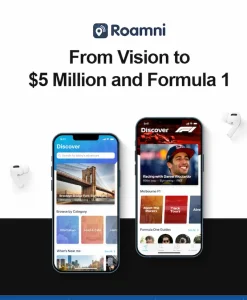
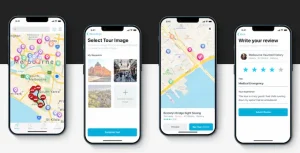
#2 Send out marketing emails
Email is a great communication channel you can use to promote your app. It’s free or low cost, easy to set up, and can reach large numbers of people instantly.
The average open rate for email marketing across various industries is about 20%. This means if you have 100 potential app users, there’s a good chance 20 of them will read app promotional emails you send them.
And even if you have to spend some cash designing and sending email newsletters, it is still worth it. According to Entrepreneur, every dollar spent on email marketing yields a return of $40.
Vital to any email marketing collateral is a catchy subject line that does not look spammy. An email campaign with the right subject line can help enlarge your pool of potential app users.
Email marketing collaterals should also include basic information about the app, such as its features and where people can download it.
You can even send marketing emails even if you only have an app idea. Remember the local groups that I mentioned in Tip #1? Getting their email addresses during the app conceptualization stage will enable you to use email communication to validate your app concept.
To make sure your emails don’t end up in spam, you can also use a DKIM checker to confirm they’re properly set up.
#3 Leverage social media channels
In many cases, creating pages on social media networks is free. It is on these pages where you can post information, app screenshots, and even videos of your app without paying a cent.
You could also join social media communities like Facebook groups. Each group often comprises members that share a common line of work, interest, or topic. Look out for any groups whose interest matches your app’s value proposition.
For example, if you promote an app that simplifies mathematics, look for groups of students or educators who need help with that subject.
Aside from being free, social media platforms have a wide global reach. Statistics show that around 4 to 5 billion people use social media.
However, take note that there are many app-making competitors on social media. Therefore, strategic use of platforms like Facebook, Twitter, etc., is very important. Each of these social media sites has unique advantages in targeting audiences and effectiveness in showcasing visuals of the app in action.
#4 Collaborate with influencers
Another great way to get the word out while incurring minimal cost is to reach out to influencers.
These social media celebrities can effectively spread the word about your app, especially if their content matches your app’s functionality and target audience. But, of course, they must also have a respectable reputation.
One major example of an influencer-driven app-promoting campaign is that of Dunkin’ Donuts. The food industry giant increased its app download stats by around 60% after partnering with an influencer named Charli D’Amelio.

Source: Insider.com
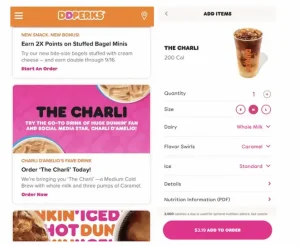
Source: Insider.com
Working with influencers also tends to cost less than contracting with traditional advertising companies. Many of these online stars are willing to receive gifts instead of fees for promoting apps. It also doesn’t hurt that each influencer can have a thousand to a million followers, greatly increasing the chances of a successful app marketing campaign.
#5 Turn your app into a marketing tool
Your app should be its own salesperson.
What do I mean by this? Two things: social share buttons and app icon design.
If your app has a social share button, it’ll enable your users to share your app quickly using online services like Gmail, Facebook, Twitter, etc. Given that Facebook alone has around 3 billion users, including the button in your custom-made app would be a great idea.
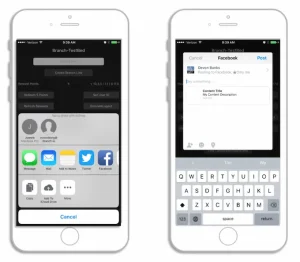
Source: Branch.io
On the other hand, app icon design is about more than just good looks. There is a way to design icons to increase app downloads. You can read our in-depth guide on how to design an app icon to learn more about this technique. This guide explains how the right app icon design can make your app stand out from millions of others in app stores.
#6 Use referral programs
Word-of-mouth has been a marketing tool for thousands of years. And it has not shown signs of slowing down.
But word-of-mouth has undergone a digital reinvention. Companies big and small are using so-called referral programs to reward people who spread the word about their apps.
For example, as the screenshots below show, both Airbnb and Uber Eats offer discounts in exchange for promoting their apps.
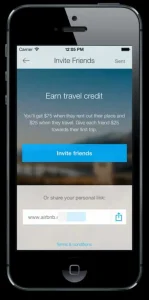
Source: ReferralMarketingSchool.org
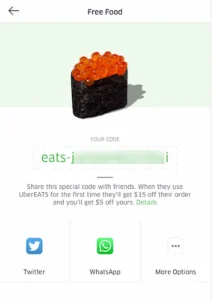
Source: ReferralMarketingSchool.org
In effect, these two companies are promoting their apps for free. Granted, Uber Eats and Airbnb have to sacrifice slight decreases in their revenue due to promos. However, this amount is still much less than the fees charged by most advertising companies. And the beauty about promos is they can be stopped at will, unlike your typical advertising contract.
#7 Explore alternative app stores
Sometimes, being a big fish in a small pond is better.
As of writing, Google Play Store and the Apple App Store have about five million apps combined. Instead of publishing and promoting your app in either store, you can go for an arena with fewer rivals.
App stores like Amazon Appstore, Tencent MyApp, and 360 Mobile Assistant tend to have a smaller user base because of their limited geographic reach. But the relative scarcity of competition can make it easier for your app to stand out, especially if your target market coincides with these three app stores’ coverage area.
In short, you can save on app promotion costs if you go for the smaller app stores.
#8 Monitor user feedback in app store listings
Instead of paying for app store ads, why not monitor user feedback on your app store listing?
Whenever your app is listed on the Google Play Store, the Apple App Store, etc., users can leave reviews or feedback on it.
If too many people complain about your app on these stores, they may discourage new users from coming in.
Remember, marketing or promoting an app is as much about ensuring current app users are happy or satisfied as it is about acquiring new users.
Source: “Udacity” YouTube Channel
One thing I learned as a customer relations specialist back in the day is that whenever clients complain, you have to give them something, even if it’s not what they actually want. For instance, when I couldn’t cancel a customer’s hotel booking due to policy restrictions, I provided them with a much cheaper hotel alternative of the same level of quality to what they booked.
Similarly, it would help if you didn’t leave any negative app feedback unanswered.
Of course, do what you can to fix what problem your app has. But remember to first reply to the negative feedback about your app. A good reply could include a formal apology and an assurance that the issue will be fixed. You could also share troubleshooting tips like phone reboots or app restarts.
If you provide your disgruntled user with useful information, your app’s negative reputation will likely be reduced.
#9 Consider using app review sites
You can also have your app featured on review sites. These websites assess and rate how good (or bad) apps are. Therefore, you must ensure your app performs well and reliably before submitting any relevant information to these sites. Otherwise, you could get a bad review.
Also, make sure that your app category matches the review site in question. For instance, if your app helps customers buy stuff online, don’t submit to a website that dishes out game app reviews.
App review sites are a good marketing complement to publishing on app stores. There are millions of apps competing for space in these online stores. Hence, an app store optimization strategy is necessary to improve your app’s visibility to those searching for mobile apps. But this visibility costs money.
If you think your funds are better used elsewhere other than app store optimization, you can improve the chances of your app getting attention through app review sites. Many such websites don’t charge money to publish reviews about your app.
App promotion that frees up cash
Wise use of marketing funds is crucial for any business. I hope that with this article, you have learned how to promote apps without spending excessively.
App-promoting activities don’t have a monopoly on cost-effectiveness. Techniques for getting the most out of every dollar spent are also possible in marketing businesses. In particular, apps are excellent tools for promoting businesses nowadays.
For instance, the app we developed for MyDeal was so good at marketing the e-commerce business, its gross sales increased by around 100% a year after app development.

Whether you’re just starting as an entrepreneur or are already an app business veteran, you can benefit from our years of experience building and growing apps. Book us a free consultation to delve deeper into how to promote apps or use them for marketing your business.
Frequently asked questions (FAQs)
How can an app be promoted?
An app can be promoted through paid or unpaid means. Paid app promotions require monetary investment while unpaid ones cost little to nothing. App-promoting methods that require payment include search ads, advertisements on app stores like Apple search ads, and social media advertising.
Unpaid app promotion methods are especially advantageous to businesses or organizations with limited capital or funding. Through techniques such as the use of social media platforms, sending out marketing emails, networking with influencers, and designing apps for your local community, you can open up avenues to maximize your app’s reach while spending almost nothing on promotional materials.
How much does it cost to promote a new app?
Promoting a new app for an extended period can cost between $5,000 and $50,000, depending on your app marketing strategy.
Market research, which is instrumental to app promotional campaigns, can range between $5,000 and $15,000 per research cycle. Public relations outreach can cost between $20,000 to $50,000 per month.
For more information, check out our guide on app marketing costs.
How do you get your app noticed?
You can take advantage of both digital and traditional marketing techniques to get your app noticed.
If you publish your app in large-scale app stores like the Google Play Store and the Apple App Store, you must know something about App Store Optimization so your app will get the attention it needs to gain market traction. This digital marketing technique, also known as ASO, mainly involves tweaking the settings and content of your app listing to ensure users can easily find it when searching on app stores.
Other digital methods to get your app noticed include paid means like search ads and social media advertising.
You can also leverage traditional marketing techniques like running a contest, organizing in-person events, and turning your users into advocates through Dropbox- and Airbnb-style incentive programs in order to attract attention to your app.

Jesus Carmelo Arguelles, aka Mel, is a Content Marketing Specialist by profession. Though he holds a bachelor’s degree in business administration, he also took courses in fields like computer troubleshooting and data analytics. He also has a wealth of experience in content writing, marketing, education, and customer support.


